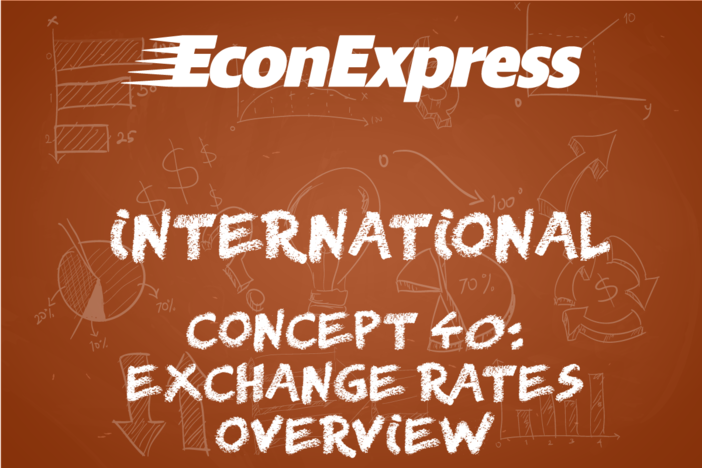Concept 40: Exchange Rates Overview
Overview: Pesos, dollars, and rupees - oh my! With so many different currencies in the world, buying and selling goods and services across borders can get complicated. This lesson explains how trading currencies works.
Learn
Beginner

Most countries use their own money, or currency, as the standard for pricing goods, services and wages. For example, in the United States we set prices in terms of U.S. dollars, but in Mexico, prices are in Mexican pesos. Because countries trade and people travel between countries, it is important to be able to translate these prices into a familiar currency. For example, how much does a good with a price of 10 pesos cost in U.S. dollars? To answer this question, you would need to know the exchange rate.
Exchange rates tell how much one currency is worth in terms of another. These rates are typically expressed as how much 1 unit of a currency will buy of the other. 1 USD = 10 pesos or 100 yen = 1 USD, for example. Once you know the exchange rate, you can convert prices of other countries’ goods and services into U.S. dollars to determine if you are getting the price you want.
Intermediate

Because the global economy is so large and involves so many countries with changing economic conditions, exchange rates fluctuate daily. This means that every day, a specific country’s currency is likely changing in value compared to other currencies. On any given day, the U.S. dollar might be worth more or fewer Mexican pesos than the day before.
When the U.S. dollar (or any currency) purchases more of another currency than it did before, it is said to have appreciated against that other currency. Conversely, when a currency purchases less of another currency than it did before, it is said to have depreciated against that currency. It is possible for a currency like the U.S. dollar to appreciate against one currency, say the Mexican peso, while also depreciating against another currency, say the Japanese yen. The reasons for changes in exchange rates are explained in greater detail in Concept 41: Foreign Exchange Markets.
Advanced

When exchange rates fluctuate, consumers within a country may not immediately notice. After all, a change in the rate between the U.S. dollar and the Swiss franc probably will not change the price of bread or milk in the average supermarket. But the changes in exchange rates do affect the purchasing power of a currency for goods produced in foreign markets. If the U.S. dollar appreciates against the Mexican peso, goods produced in Mexico become cheaper in U.S. dollars because the dollar buys more pesos. Also, this means that goods produced in the United States become more expensive for people using pesos, as every peso buys fewer U.S. dollars.
This has significant implications for specific groups in each country, who might be said to “win” or “lose” based on the fluctuation of currency rates. For example, when the U.S. dollar appreciates against another currencies, U.S. importers are helped because they can use fewer dollars to import their goods. Conversely, U.S. exporters are hurt because domestic goods become more expensive to the other countries, as it takes more of the foreign currency to buy the U.S. good. Another group that is helped or hurt by exchange rate fluctuations is international tourists, who may see their purchasing power increase or decrease as they trade their domestic currency for the foreign currency needed during travel.
Click a reading level below or scroll down to practice this concept.
Practice
Assess
Below are five questions about this concept. Choose the one best answer for each question and be sure to read the feedback given. Click “next question” to move on when ready.
Social Studies 2024
Describe factors that cause changes in exchange rates.







